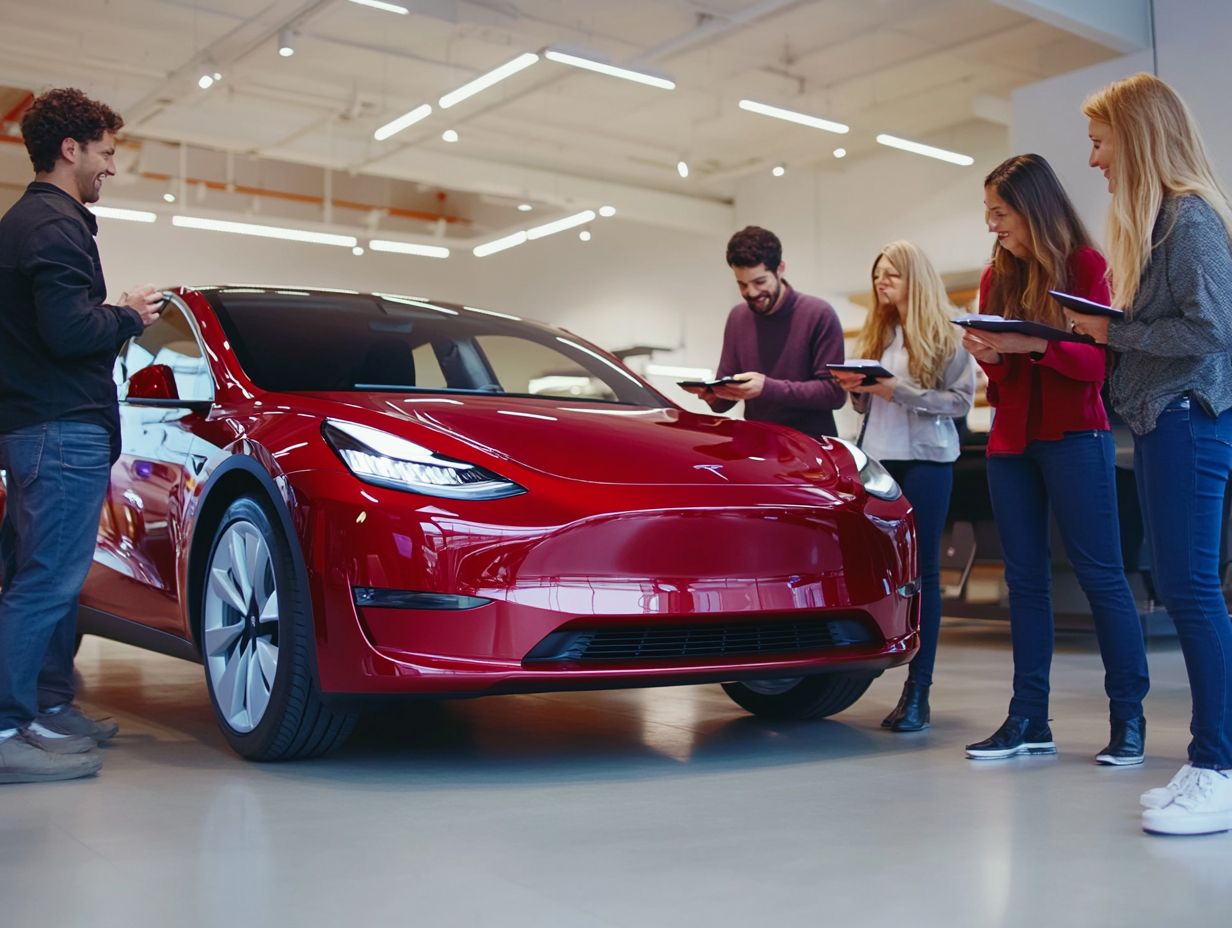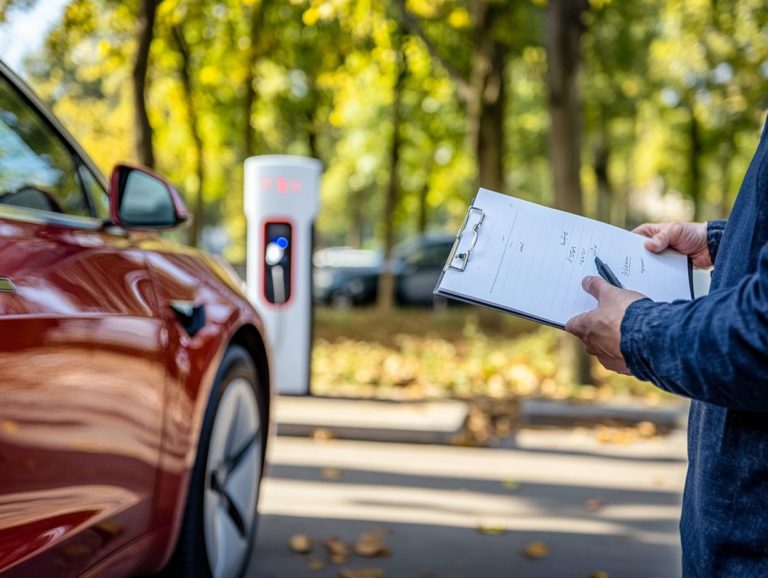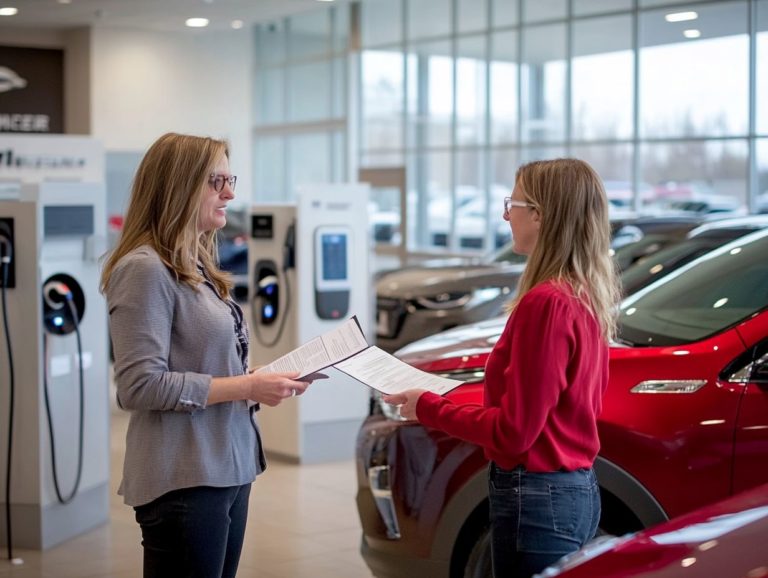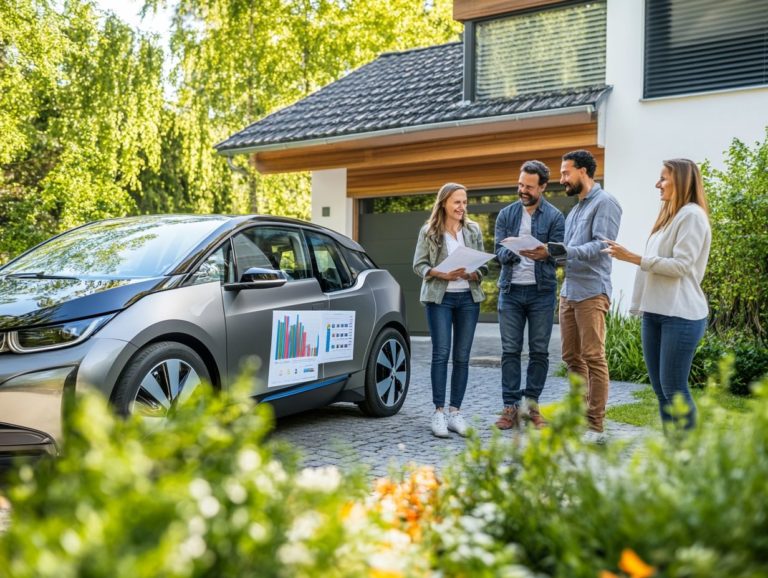A Beginner’s Guide to Buying Electric Vehicles
Electric vehicles (EVs) are revolutionizing transportation by seamlessly combining innovation, sustainability, and cost-effectiveness. Join the EV revolution!
This guide delves into the essence of electric vehicles, highlighting their environmental and financial advantages. You will discover the various types available, including Battery Electric Vehicles (BEVs), which run only on electricity, and Plug-in Hybrid Electric Vehicles (PHEVs), which use both electricity and gasoline.
This guide also covers important factors to consider when purchasing an EV, guiding you on how to select the perfect model tailored to your needs. Plus, you ll find practical ownership tips.
Whether you’re embarking on your first EV journey or simply exploring your options, this guide empowers you with the insights needed to make informed choices and embrace a more environmentally friendly future.
Contents
- Key Takeaways:
- Benefits of Electric Vehicles
- Types of Electric Vehicles
- Factors to Consider When Buying an Electric Vehicle
- How to Choose the Right Electric Vehicle for You
- Tips for Owning and Operating an Electric Vehicle
- Frequently Asked Questions
- 1. What are the key benefits of electric vehicles?
- 2. What factors should I consider when buying an electric vehicle?
- 3. How much does it cost to charge an electric vehicle?
- 4. Can I take my electric vehicle on long road trips?
- 5. Are electric vehicles safe to drive?
- 6. Are there any downsides to buying an electric vehicle?
Key Takeaways:

- Electric vehicles offer environmental and cost benefits, making them a great option for eco-conscious and budget-minded buyers.
- When purchasing an electric vehicle, consider factors such as range, charging options, costs, incentives, safety, and maintenance.
- Assess your needs and budget before choosing the right electric vehicle for you. Proper charging and maintenance will ensure optimal performance.
What are Electric Vehicles?
Electric vehicles (EVs) are rapidly becoming a significant part of the automotive market. They rely on electricity rather than traditional fossil fuels, presenting a more sustainable transportation option.
Thanks to technological advancements, models like the Tesla Model X, Ford I-Pace, Hyundai Kona, and Volkswagen e-Up are leading the way, redefining what driving efficiency and vehicle reliability can achieve. You ll find these vehicles in categories such as Battery Electric Vehicles (BEVs), Hybrid Vehicles, and Plug-in Hybrids (PHEVs), each offering distinct benefits tailored to your lifestyle.
The importance of electric vehicles extends far beyond mere convenience; they are essential in the battle against climate change by significantly reducing carbon emissions. For instance, the Tesla Model X not only delivers exceptional performance but also minimizes your overall carbon footprint compared to conventional SUVs. Similarly, the Hyundai Ioniq and Volkswagen e-Up demonstrate how efficient energy consumption can fit seamlessly into your daily commute, making them appealing alternatives.
The growing network of public charging stations, coupled with the ease of home charging, enhances the practicality of owning an EV. This means you can recharge effortlessly and efficiently, paving the way for a cleaner, more sustainable future.
Benefits of Electric Vehicles
Electric vehicles (EVs) present numerous advantages that extend beyond just reducing reliance on fossil fuels. They offer substantial environmental benefits, provide significant savings on fuel costs, and often come with enticing tax credits, enhancing their appeal.
Furthermore, electric vehicles are designed with advanced technologies, such as regenerative braking, a feature that helps recharge the battery while slowing down, optimizing efficiency and contributing to overall energy savings during operation.
Environmental and Cost Benefits
The environmental and cost benefits of electric vehicles (EVs) are compelling. Not only do they significantly reduce greenhouse gas emissions compared to traditional combustion engines, but they also offer impressive savings on fuel and maintenance costs.
Studies reveal that EVs emit approximately 60% fewer emissions over their lifetime than gasoline-powered cars, even when considering electricity generation. That translates to a remarkable reduction of nearly 4.6 metric tons of carbon dioxide per vehicle each year.
As an electric vehicle owner, you could save between $400 and $1,000 on fuel costs annually, all thanks to the lower price of electricity compared to gasoline. Maintenance expenses also decrease, with fewer moving parts leading to lower service costs averaging around $300 less each year compared to traditional vehicles.
As the adoption of EVs continues to rise, these financial and environmental benefits become even more pronounced, encouraging a broader transition towards cleaner transportation.
Types of Electric Vehicles
Electric vehicles come in several distinct types, each boasting unique characteristics and benefits.
You have Battery Electric Vehicles (BEVs), such as the Tesla Model S and Hyundai Ioniq, which run only on electricity. Then there are Plug-in Hybrid Electric Vehicles (PHEVs), blending electric power with gasoline engines, making them a perfect choice for many drivers!
This flexibility is perfect for many drivers, catering to varied preferences and driving needs.
Battery Electric Vehicles (BEVs)

Battery Electric Vehicles (BEVs) are cars that run only on electricity. A robust charging network is essential for their use, and they are often praised for their energy efficiency and reduced environmental impact.
Leading the charge, models like the Tesla Model S and Hyundai Kona exemplify cutting-edge technology that optimizes battery performance and efficiency.
These vehicles use advanced battery technology, enhancing their eco-friendly image while offering impressive range capabilities. The Tesla Model S is celebrated for its long-range performance and remarkable acceleration, making it a favorite among electric car enthusiasts. Meanwhile, the Hyundai Kona offers a compact yet powerful option, complete with user-friendly charging solutions that simplify everyday driving.
Both models benefit significantly from the growing charging infrastructure, which includes the network of places where you can charge your vehicle. This development makes the shift to electric driving not only smoother but also more appealing.
Plug-in Hybrid Electric Vehicles (PHEVs)
Plug-in Hybrid Electric Vehicles (PHEVs) blend the benefits of traditional gasoline engines with electric power. With vehicles like the Mini Electric and Chevrolet Volt, you can enjoy enhanced fuel economy and lower emissions while retaining the convenience of a conventional ride.
You can charge them at home or take advantage of public charging stations, making them a compelling choice for many drivers. Unlike standard hybrids that primarily rely on gasoline engines, PHEVs let you drive entirely on electric power for short commutes, typically between 25 to 50 miles on a single charge.
This not only leads to significant fuel savings but also reduces your carbon footprint, benefiting both the environment and your wallet.
For example, the Toyota RAV4 Prime allows you to switch between electric and gasoline modes, providing the versatility needed for longer journeys without worrying about running out of charge. This flexibility makes PHEVs attractive for those seeking eco-friendly advantages without sacrificing the convenience of traditional fuel options.
Factors to Consider When Buying an Electric Vehicle
When contemplating the purchase of an electric vehicle (EV), many factors require your attention. You’ll want to consider the vehicle’s range, the charging options available, the overall cost, and crucial elements of safety and maintenance. For a comprehensive overview, refer to the ultimate checklist for EV buyers.
Understanding these key components amplifies the benefits of your investment and enhances your entire journey into the realm of electric mobility.
Range and Charging Options
When selecting an electric vehicle (EV), it’s essential to consider range and charging options. Additionally, understanding EV financing options can greatly influence your purchase decision, as these factors directly impact your everyday utilization and practicality.
Understanding the nuances of home charging versus public charging, along with the different types of chargers available, like very fast chargers and Level 2 chargers, can significantly shape your ownership experience.
As you think about your daily commutes and longer road trips, having a solid grasp of your EV s driving range is crucial. A vehicle with an impressive range can ease concerns about running out of juice.
This allows you to embrace spontaneous adventures without the nagging worry of locating a charging station.
With a variety of charging options available, such as installing a home charging station for overnight use or tapping into the extensive network of public chargers, you ll enjoy the flexibility to charge on your terms. This reliable network enhances your convenience and fosters the increasing adoption of electric vehicles.
Cost and Incentives
Understanding the cost structure associated with electric vehicles (EVs) is crucial for you as a prospective buyer. It goes beyond just the initial purchase price and includes ongoing ownership costs, potential tax credits, and available incentives. For comprehensive guidance, consider exploring how to choose the right EV for your lifestyle.
These incentives can significantly lighten your financial load and make the switch to electric a savvy financial decision.
When considering an EV, explore expenses like maintenance, generally lower due to fewer moving parts compared to traditional vehicles. Insurance can also vary, so it’s wise to shop around for the best rates.
The savings on fuel thanks to the reduced costs of electricity compared to gasoline can accumulate over time.
Federal tax credits can deliver substantial savings right at the point of purchase, while local incentives might further enhance overall affordability. By examining these factors, you can better understand the long-term financial benefits of transitioning to electric and make a well-informed decision.
Safety and Maintenance

When considering the purchase of an electric vehicle (EV), safety and maintenance should be at the forefront of your mind. To make an informed decision, check out how to choose the best EV for your budget. These factors are essential for vehicle reliability and enhancing your overall ownership experience.
Many modern electric cars boast advanced safety features, making it crucial to understand their maintenance needs for ensuring longevity and optimal performance.
Consumer reports frequently reveal that EV safety ratings often exceed those of traditional gas-powered vehicles, thanks to innovative design and cutting-edge technology.
Features like automatic emergency braking, adaptive cruise control, and strong structural integrity elevate safety standards.
It’s important to note that maintenance requirements for EVs differ considerably. You won t have to worry about oil changes, and there are fewer mechanical components that face wear and tear.
This can translate into lower long-term maintenance costs and less frequent trips to the repair shop. By understanding these distinctions, you can make well-informed decisions about investing in electric mobility.
How to Choose the Right Electric Vehicle for You
Choosing the right electric vehicle (EV) for your lifestyle requires a thoughtful evaluation of your needs and budget. To make an informed decision, consider these EV buying tips to ensure the model you select aligns perfectly with your daily requirements, driving habits, and financial capabilities.
This journey may involve test-driving several models to discover which vehicle resonates with you the most. Are you ready to discover the perfect EV for your lifestyle?
Assessing Your Needs and Budget
Assessing your needs and budget is an essential step in selecting the right electric vehicle (EV). This process helps you pinpoint the features that matter most to you and determine how much you’re willing to invest. For a deeper understanding of the process, refer to a comprehensive guide to EV test drives. Consider factors like your daily commute and the desired vehicle features. Also, think about available incentives that could affect your overall expenditure.
Reflecting on your driving habits can guide you toward models that align with your lifestyle. For instance, if you often embark on long journeys, prioritizing battery capacity becomes crucial.
Next, create a comprehensive budget that covers not just the initial purchase price but also ongoing expenses like insurance, maintenance, and charging. Don t forget to account for potential savings from fuel efficiency and any applicable tax credits or rebates.
These considerations can significantly influence the total cost of ownership, guiding you toward a vehicle choice that meets both your financial and personal priorities.
Tips for Owning and Operating an Electric Vehicle
Owning and operating an electric vehicle (EV) can be incredibly rewarding, especially when you understand how to prepare for your first electric car. By adhering to specific guidelines, you can optimize your driving experience and extend the longevity of your vehicle, fully embracing the myriad benefits of electric mobility.
Charging and Maintenance Guidelines
Charging and maintenance guidelines are crucial for EV owners, helping maximize performance and longevity. By adopting proper charging habits whether at home or public charging stations you can significantly boost both the efficiency and lifespan of your EV. Regular maintenance is also important to keep your vehicle in optimal condition.
Understanding the various types of chargers available like Level 1, Level 2, and DC fast chargers will enable informed decisions about your charging habits. At home, utilizing a Level 2 charger can dramatically reduce your charging time compared to a standard outlet. When you’re out and about, public charging stations typically offer a mix of DC fast charging and Level 2 options to cater to your needs.
Maintenance tasks unique to EVs, such as checking battery health (the condition and efficiency of the battery) and performing software updates, differ from the typical oil changes you d do for traditional vehicles. Following your manufacturer s recommended maintenance schedules is vital; it ensures longevity and efficiency while safeguarding your electric vehicle s performance for the long haul.
Frequently Asked Questions

1. What are the key benefits of electric vehicles?
Some main benefits of buying an electric vehicle include lower emissions, reduced fuel costs, and a smoother, quieter ride. Electric vehicles require less maintenance and have a longer lifespan compared to traditional gas-powered cars.
2. What factors should I consider when buying an electric vehicle?
Important factors to consider include your budget, the vehicle’s range, available charging options, and any tax incentives or rebates that may be available in your area.
3. How much does it cost to charge an electric vehicle?
The cost of charging can vary based on location and electricity prices. On average, it costs about $0.12 per kilowatt-hour to charge an electric vehicle at home, which is significantly less than gasoline costs.
4. Can I take my electric vehicle on long road trips?
Yes, as long as charging stations are available along your route. Many electric vehicles have a range of over 200 miles, and there are an increasing number of charging stations being installed across the country.
5. Are electric vehicles safe to drive?
Yes, electric vehicles are as safe as traditional gas-powered cars. Some studies suggest that electric vehicles may even have a lower risk of catching fire compared to gasoline cars.
Discover the joys of driving an electric vehicle today! Start your EV journey now!
6. Are there any downsides to buying an electric vehicle?
One main downside of buying an electric vehicle is the higher initial cost compared to traditional cars. However, you can save money on fuel and maintenance over time.
Some electric vehicles also have a limited driving range. This means you need to plan your trips carefully to avoid running out of power!






